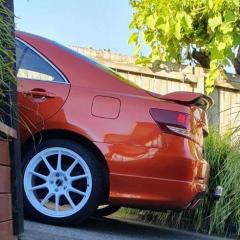-
Latest Postings
-
0
IAC for 1997 Camry Vienta (3vzfe)
I have a 1997 Camry vienta with a 3vzfe. My idle air controller is gone and I'm looking for a replacement. I came across an AISAN ISC 069 and was wondering if it's oem like denso? if not then is it a good replacement? I have also looked at GOSS and Tridon and was wondering which of them is better. Also what aftermarket brand is good in genera PAT, GOSS or tridon? cause I can't find may toyota parts for my car so I need to rely on these -
0
Aurion "wobble"
Hi all, Last weekend I became the proud owner of an Aurion zr6 2008. Looks great and the engine and trans seem to be in good condition. It has 220,000km on the clock. It does have one issue though that's bugging me. It has a slight wobble... All the time. It's not coming through the steering and the rate or wobble is directly proportionate to the speed of the car. I had brand new wheels and tyres put on the day I bought it. They were balanced and aligned. I haven't taken it to my mechanic yet but I will be this week. Hoping to get some advice from the community before I do as I'm not mechanically minded. My friend thinks it's the left rear trailing arm bushing 🤷🏻♂️ sounds plausible. Cheers. -
1
Fuel Tank transfer
Scott, See this site. I put a reply on it a few days ago re your type of problem. -
0
Kakadu GVM
Help/advice please!! I have just purchased a 2021 Kakadu which has bull bar/extra battery and now have my kids car seat, roof racks on board too. took it over the tip scales and it came in at 2,680kg with myself, missus and our son…which is as many people as we plan to carry.. BUT fuel tank was not full AND it’s the model with 150l tank so 150kg capacity/potential. we are picking up a newly ordered caravan with 2,450kg tare/ 3,000kg max which I therefore assume will add a 245kg-300kg tow ball weight to our Kakadu’s gvm…is this correct? As if so we would be well over with a full tank of fuel and then surely we are un-insurable even if we don’t fill the fuel tank? looking for advice before i ditch the Kakadu for a Landcruiser or Defender! I could remove the bull bar ($3,000) and remove the 3rd row of seats ($300) to come up with an other 75kg or so but doesn’t seem worth it….any advice/thoughts? thanks Quote -
4
Caravan towing
Help/advice please!! I have just purchased a 2021 Kakadu which has bull bar/extra battery and now have my kids car seat, roof racks on board too. took it over the tip scales and it came in at 2,680kg with myself, missus and our son…which is as many people as we plan to carry.. BUT fuel tank was not full AND it’s the model with 150l tank so 150kg capacity/potential. we are picking up a newly ordered caravan with 2,450kg tare/ 3,000kg max which I therefore assume will add a 245kg-300kg tow ball weight to our Kakadu’s gvm…is this correct? As if so we would be well over with a full tank of fuel and then surely we are un-insurable even if we don’t fill the fuel tank? looking for advice before i ditch the Kakadu for a Landcruiser or Defender! I could remove the bull bar ($3,000) and remove the 3rd row of seats ($300) to come up with an other 75kg or so but doesn’t seem worth it….any advice/thoughts? thanks -
2
-
0
Hi, I'm Magazi in NSW I'm a new member
I have a 2002 Corolla 1.8L ZZE-122R, Engine 1ZZ-FE Jap. I have 2 different scan tools {Jaycar Protech PP2147 & Actron AutoScanner CP9576). Both scan tools say DATA ERROR Connection, have tried scan tools out on 3 other different cars and all is OK with the scan tools,just got the car back from the mechanic and he says there is no problem with the OBD data connection. Can anyone point me in the right direction as far as which scanner would work. Thanks Maga -
0
How to reset service interval light
Anyone know exactly what the little spanner light means and how to reset it? Best info I have so far is that this is the service interval light. The trouble is I don't know how to reset it. Instructions given say, press and hold the odometer button. There isn't one. There's the "display" button on the steering wheel but that does not reset the little orange spanner warning light. -
5
Tyres
Bob jane and tyre power both said these are not recommended and they wear very quickly? They suggested the Michelin xm2+ or the toyo proxes c100? but have read bad reviews on those -
7
1998 Toyota Celica Pricing idea
One of the only things working against (or for, depending on your viewpoint) the ST204 Celica is that a bunch of them were probably crushed as a result of not being able to source replacement airbags during the Takata recall (a similar fate befell the Starlet). I don't think all models had that particular airbag though so it probably disproportionally affected certain trim-levels too. This might artificially inflate the rarity of what was generally seen as a nondescript uninspiring 90s hair-dresser "sports car" that still sold reasonably well.
-





Recommended Posts
Join the conversation
You can post now and register later. If you have an account, sign in now to post with your account.